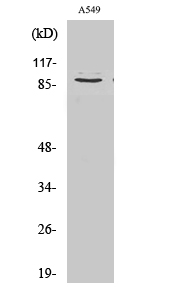Cleaved-COL3A1 (G1221) Cell-Based Colorimetric ELISA Kit
- Catalog No.:KA3949C
- Applications:ELISA
- Reactivity:Human
- Gene Name:
- COL3A1
- Human Gene Id:
- 1281
- Human Swiss Prot No:
- P02461
- Mouse Swiss Prot No:
- P08121
- Storage Stability:
- 2-8°C/6 months
- Other Name:
- Collagen alpha-1(III) chain
- Detection Method:
- Colorimetric
- Background:
- disease:Defects in COL3A1 are a cause of Ehlers-Danlos syndrome type 3 (EDS3) [MIM:130020]; also known as benign hypermobility syndrome. EDS is a connective tissue disorder characterized by hyperextensible skin, atrophic cutaneous scars due to tissue fragility and joint hyperlaxity. EDS3 is a form of Ehlers-Danlos syndrome characterized by marked joint hyperextensibility without skeletal deformity.,disease:Defects in COL3A1 are a cause of susceptibility to aortic aneurysm abdominal (AAA) [MIM:100070]. AAA is a common multifactorial disorder characterized by permanent dilation of the abdominal aorta, usually due to degenerative changes in the aortic wall. Histologically, AAA is characterized by signs of chronic inflammation, destructive remodeling of the extracellular matrix, and depletion of vascular smooth muscle cells.,disease:Defects in COL3A1 are the cause of Ehlers-Danlos syndrome type 4 (EDS4) [MIM:130050]. EDS is a connective tissue disorder characterized by hyperextensible skin, atrophic cutaneous scars due to tissue fragility and joint hyperlaxity. EDS4 is the most severe form of the disease. It is characterized by the joint and dermal manifestations as in other forms of the syndrome, characteristic facial features (acrogeria) in most patients, and by proneness to spontaneous rupture of bowel and large arteries. The vascular complications may affect all anatomical areas.,function:Collagen type III occurs in most soft connective tissues along with type I collagen.,online information:Collagen type III alpha-1 chain mutations,online information:Type-III collagen entry,PTM:O-linked glycan consists of a Glc-Gal disaccharide bound to the oxygen atom of a post-translationally added hydroxyl group.,PTM:Proline residues at the third position of the tripeptide repeating unit (G-X-Y) are hydroxylated in some or all of the chains.,similarity:Belongs to the fibrillar collagen family.,similarity:Contains 1 VWFC domain.,subunit:Trimers of identical alpha 1(III) chains. The chains are linked to each other by interchain disulfide bonds. Trimers are also cross-linked via hydroxylysines.,
- Function:
- skeletal system development, blood vessel development, cell activation, vasculature development, negative regulation of immune system process, cell adhesion, cell-matrix adhesion, cell surface receptor linked signal transduction, enzyme linked receptor protein signaling pathway, transmembrane receptor protein serine/threonine kinase signaling pathway, transforming growth factor beta receptor signaling pathway, integrin-mediated signaling pathway, ectoderm development, heart development, blood coagulation, hemostasis, epidermis development, response to radiation,response to wounding, response to abiotic stimulus, response to organic substance, peptide cross-linking, biological adhesion, platelet activation, extracellular matrix organization, collagen fibril organization, cell-substrate adhesion,collagen metabolic process, collagen biosynthetic process, response to cytokine stimulus, wound
- Subcellular Location:
- Secreted, extracellular space, extracellular matrix .
- June 19-2018
- WESTERN IMMUNOBLOTTING PROTOCOL
- June 19-2018
- IMMUNOHISTOCHEMISTRY-PARAFFIN PROTOCOL
- June 19-2018
- IMMUNOFLUORESCENCE PROTOCOL
- September 08-2020
- FLOW-CYTOMEYRT-PROTOCOL
- May 20-2022
- Cell-Based ELISA│解您多样本WB检测之困扰
- July 13-2018
- CELL-BASED-ELISA-PROTOCOL-FOR-ACETYL-PROTEIN
- July 13-2018
- CELL-BASED-ELISA-PROTOCOL-FOR-PHOSPHO-PROTEIN
- July 13-2018
- Antibody-FAQs


